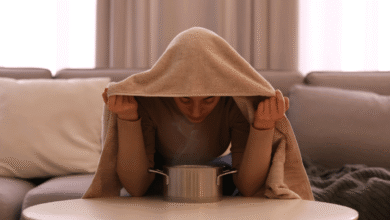
Bentonite clay has become popular once again. But this time, it’s especially being promoted for its use in a detoxifying bath. As we encounter more and more toxins daily, many of us want some easy DIY ways to detox. Bentonite clay baths can help support our natural detox pathways. There’s even a side benefit: soft, clear skin.
Here’s what you need to know about bentonite clay baths.
What is Bentonite Clay?
Bentonite clay is a group of minerals that forms from aged volcanic ash. It’s also called montmorillonite clay. When the ash is exposed to water over time, it becomes bentonite clay. There are two types: sodium bentonite and calcium bentonite.
Sodium bentonite clay is known for its swelling properties. It can absorb large amounts of water and expand several times its volume. For that reason, it’s often used in industrial applications, including landscaping and cat litter. It’s also used to improve soil quality and as a feed additive for livestock.
Calcium bentonite clay has less swelling ability. It’s the one used as a healing clay for both internal and external uses. You’ll see calcium bentonite on the ingredients list of face masks and bath salts.
How Does Bentonite Clay Benefit the Skin?
Bentonite clay can attract and hold particles on its surface, making it useful for detoxification. The particles also carry a negative charge. This means it can attract positively charged substances like toxins, pathogens, and heavy metals. Here are some known uses for bentonite clay and skincare via a detox bath:
- Draws out dirt and impurities: The clay’s fine particles can penetrate deeply into the pores, drawing out dirt, dead skin cells, and other impurities. As a result, it helps maintain clear skin.
- Oil absorption: Bentonite clay also absorbs excess oils from the skin, making it beneficial for people with oily or acne-prone skin. This helps in preventing clogged pores and reducing shine.
- Calming inflammation: Bentonite clay has anti-inflammatory properties. It can soothe irritated skin, reduce redness, and calm conditions like eczema.
Bentonite clay is generally considered safe for topical use, but it’s always good to do a patch test to check for allergic reactions.
Why Do a Bentonite Detox Bath?
Soaking in a bentonite-infused warm bath can tackle more than everyday exposure to pollutants. It can help eliminate metal toxicity, bacterial and viral infections, and parasites. The minerals in bentonite clay help nourish the skin, promoting cell regeneration and repair. It can also reduce inflammation and promote overall wellness.
What Can Bentonite Help Detox?
Here are some more specifics on what bentonite clay may help detox.
Heavy Metals
We’re exposed to toxic metals daily –through our food, water, and environment. Bentonite clay baths are touted for their ability to detoxify the body by drawing out toxins and heavy metals through the skin. It may also help detoxify lead, mercury, aluminum, cadmium, arsenic, and copper.
Bentonite works by drawing heavy metals and other impurities in and holding them there. Like many substances bentonite clay does have some lead, but here’s why I’m not worried about it.
Infections
Bentonite clay also adsorbs and removes pathogens, including bacteria, viruses, and parasites. A bentonite clay bath may help detoxify the following:
- E. coli: Bentonite clay has been shown to bind to Escherichia coli, a common cause of food poisoning.
- Staphylococcus aureus: Bentonite can also adsorb Staphylococcus aureus. This bacterium is known to cause serious skin infections. It can even lead to antibiotic-resistant strains like MRSA.
- Salmonella: Bentonite clay can bind to Salmonella bacteria. This infection is a major cause of food poisoning.
- Rotavirus: Bentonite clay can also help bind viruses. It may help adsorb rotavirus, a common cause of severe diarrhea in children.
- Norovirus: Bentonite can also adsorb norovirus, another virus that causes gastroenteritis.
- Giardia: Giardia lamblia is also susceptible to bentonite clay’s binding effects. Giardia is a parasite that causes giardiasis, an intestinal infection.
- Helminths: Certain parasitic worms or their eggs may be adsorbed by bentonite clay. However, at this point, the evidence is more anecdotal.
Mold Toxins
Bentonite clay is also known to bind and remove mold toxins like aflatoxins. Aflatoxins are produced by certain molds like Aspergillus flavus and Aspergillus parasiticus. Bentonite clay’s adsorptive properties can help draw mycotoxins out of the body through the skin. A hot bath can also promote sweating, further aiding in the removal of mycotoxins through the sweat.
Who Might Want to Consider a Bentonite Clay Detox Bath?
A bentonite clay detox bath can be beneficial for a variety of issues beyond general detoxification. Here are some reasons why you might want to do a bentonite clay detox bath:
- Insect Bites: If you’ve battled mosquitos all summer and are still scratching bites, try a bentonite bath! It’s known to soothe irritations and calm itching. I’ve even included it in my homemade anti-itch cream.
- Poison Ivy: Bentonite clay may help alleviate poison ivy symptoms like itching, redness, and swelling. Soak in the bentonite bath for 20-30 minutes. Rinse off with cool water after soaking and gently pat your skin dry.
- Sunburn: Bentonite’s anti-inflammatory and soothing properties make it an excellent remedy for sunburn. Start with a lukewarm bath and soak the burn away.
- Rough, calloused feet: Have you noticed your feet are getting a bit rough or calloused? A bentonite bath (or foot soak) may help. The clay can soften skin and draw out a buildup of dead skin cells.
- Skin Conditions: Bentonite clay has been known to soothe the symptoms of certain skin conditions like eczema and psoriasis. It likely does so by reducing inflammation and providing minerals for healing.
- Athletes and those who are physically active: Athletes and those who engage in intense physical activity may use bentonite clay baths to aid in recovery. It helps reduce muscle soreness and draws out toxins.
Here’s how to prepare a bentonite clay detox bath.
How to Do a Bentonite Detox Bath
Add 1-2 cups of bentonite clay powder to a bathtub filled with warm water (not hot water) and soak for 20-30 minutes. This can help detoxify and soften the skin all over your body. Drink a glass of water before and after the bath to stay hydrated. Detox baths can be dehydrating.
You can add other ingredients to enhance the healing capabilities. Here are a few examples:
- Epsom Salts: Epsom salts (magnesium sulfate) can help relax muscles, reduce cramps, and alleviate sore muscles. Epsom salts also support detoxification by aiding the body’s natural elimination processes. For added benefits measure 1-2 cups Epsom salt and add to the bentonite clay in bath water.
- Sea Salt or Himalayan Salt: Adding sea salt or Himalayan salt to a bentonite bath is another option. These natural salts contain a variety of minerals, including magnesium, potassium, calcium, and sodium. Skin can absorb minerals during a bath, supporting overall health and well-being.
- Baking Soda: Baking soda (sodium bicarbonate) is another natural compound that can help support detoxification. It’s alkalizing to help neutralize acids and promote a balanced body pH.
Adding Essential Oils
Adding a few drops of essential oils like lavender, peppermint, tea tree, or eucalyptus elevates the senses. These oils also have researched anti-inflammatory and healing abilities. They also support the respiratory system, further promoting detoxification through the lungs.
Be sure to dilute any essential oils in a carrier oil first to avoid skin irritation! Harsher oils like peppermint and eucalyptus can work well in a foot bath but may be too strong for more delicate skin.
Bentonite Bath Tips
When mixing other ingredients into bentonite clay, be sure to use non-metal utensils and containers. Metal materials can reduce the clay’s effectiveness as they can change the natural charge in the clay.
After taking a bentonite clay bath, follow up with a natural moisturizer. Sometimes bentonite clay can leave skin feeling dry. While bentonite clay can leave a residue, cleanup isn’t as hard as you might think. Just rinse and clean the tub after use to prevent a buildup.
Final Thoughts
Bentonite clay can adsorb and help remove pathogens, heavy metals, and other toxins. Using it in a bath can be a wonderful form of self-care. You can easily elevate it to a home spa experience. A warm clay bath can be an inexpensive home luxury, helping to reduce stress and tension.
Be sure to moisturize afterward with a natural lotion or even coconut oil.
Have you taken a bentonite detox bath? Do you add anything to it? Have you noticed any positive benefits? Share with us below!
Source link




